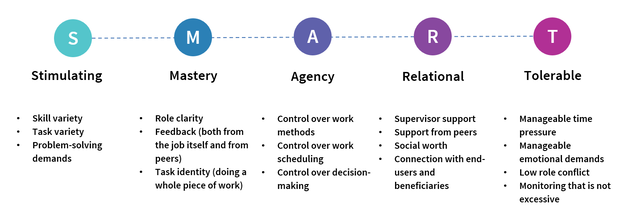On 31 March 2022, the Work Health and Safety (WHS) laws replaced the health and safety elements of the Mines Safety and Inspection laws. For information visit www.demirs.wa.gov.au/whs
All health and safety notifications, forms and guidance for mining and petroleum has moved to the WorkSafe website
The information below has been left for historical compliance reference purposes

What is good work design?
Western Australia’s work health and safety legislation requires employers to ensure, so far as is reasonably practicable, workers are not exposed to safety and health risks arising from being at work. The most effective way of protecting workers from exposure to psychosocial hazards is to use the safe design approach when designing work, including the development and implementation of systems and processes. Safe work design is about integrating hazard identification and risk assessment methods early in the design process to eliminate and minimise risks.
What are some benefits of well-designed work?
- Health promotion: Good work design can provide satisfying work and positive social interactions, which can help improve worker wellbeing.
- Productivity: Well-designed work allows for better utilisation of skills, resulting in workers who are more engaged, motivated and willing to contribute greater effort.
- Cost-savings: Good work design helps workplaces cut costs by decreasing disruptions to work processes, avoiding expensive retrofitting costs and reducing costs from workplace illnesses and injuries.
- Harm prevention: Well-designed work can eliminate the potential health risks from exposure to psychosocial hazards and risk factors, including work-related injuries and illnesses.
What are the components of good work design?
The SMART Work Design model, developed by Professor Sharon Parker at the Centre for Transformative Work Design, identifies five work characteristics for positive outcomes.
- Stimulating work means having varied, interesting and meaningful tasks in a job.
- Mastery at work comes from knowing what your role is, knowing how you are going on your tasks, and understanding how your work fits into the bigger picture.
- Agency in a job means having a sense of autonomy and control over when and how you do your tasks, as well as being able to make decisions about your job. Agency is also supported when you are asked for input into decisions and consulted about change.
- Relational work design recognises that people need connection and support at work. Examples of relational work include, being part of a team, having support from your peers and supervisor, and knowing how your work impacts on others’ lives.
- Tolerable demands at work means the things you are expected to do at work are not overwhelming. Tolerable demands can mean, for example, having reasonable work hours, not being tightly monitored, and having reasonable and consistent expectations for performance.
How can work design contribute to a mentally healthy workplace?
Work design is integral to the development of a mentally healthy workplace as it has a major impact on how individuals feel at work. For example, job insecurity, heavy work demands and a lack of control over work decisions are risk factors for work-related stress. Workers who report feeling supported and having clear roles, job control and reasonable work demands also report better mental health and wellbeing.
By considering the tasks of the job and the way in which work is done, it is possible to design jobs that support the mental health and wellbeing of the workforce. For example, strategies to make work more interesting and meaningful include job rotation, job enrichment and self-managing teams.
Failure to consider how work is designed is poor risk management and a lost opportunity to innovate and improve the effectiveness and efficiency of work.
Resources
| Principles of good work design: A work health and safety handbook (Good Work Design Handbook) |
This handbook by Safe Work Australia contains information about the ten principles of good work design and how they can be successfully applied to any workplace, business or industry. |
|
Does the evidence and theory support the Good Work Design principles? An educational resource |
This paper by Safe Work Australia sets out the evidence base and theoretical underpinning of work design, focusing particularly on psychosocial aspects of jobs. It analyses work design evidence and theory linked to the principles discussed in the Good Work Design Handbook. |
|
This publication by Health and Safety Executive, UK is designed to assist employers in implementing the Management Standards approach to help manage the causes of work-related stress. The management standards cover six key areas of work design that, if not properly managed, are associated with poor health, lower productivity and increased accident and sickness absence rates. |
|
|
Tackling work-related stress using the Management Standards approach: a step-by step workbook (2017) |
This publication by Health and Safety Executive, UK is designed to assist employers in implementing the Management Standards approach to help manage the causes of work-related stress. The management standards cover six key areas of work design that, if not properly managed, are associated with poor health, lower productivity and increased accident and sickness absence rates. |
|
This video by the Centre for Transformative Work Design provides an introduction to work design, why it’s important, and the effects of poor work design. |

